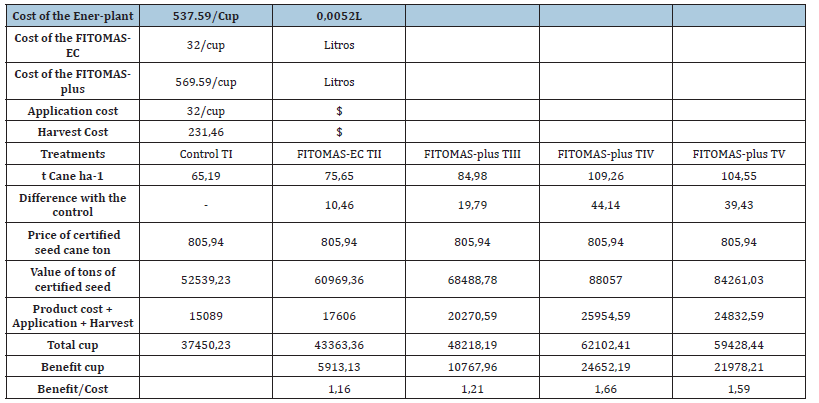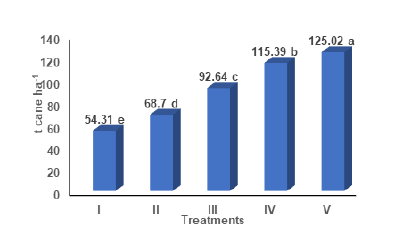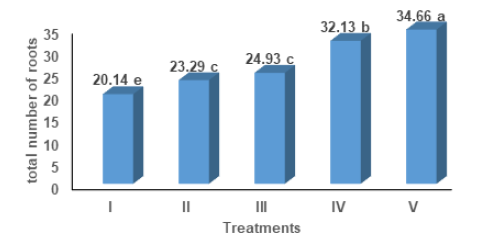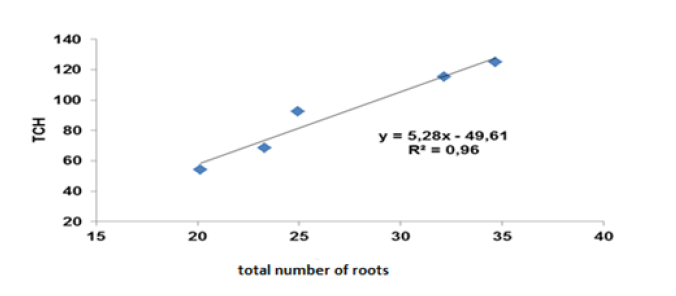- Submissions

Full Text
Journal of Biotechnology & Bioresearch
Production of Categorized Sugar Cane Seed on Agroecological Basis
Héctor Jorge Suárez1*, Reinier Crespo León2, Rafael Zuaznabar Zuaznabar1, Miguel González Nuñez1, Ignacio Santana Aguilar3 and Juan Miguel González Rodríguez1
1Sugar Cane Research Institute, Boyeros, Cuba
2Polytechnic Institute, Boyeros, Cuba
3Biotec International, Sugar Cane Research Institute, Boyeros, Cuba
*Corresponding author:Héctor Jorge Suárez, Sugar Cane Research Institute, CUJAE Highway, Boyeros, Havana, Cuba
Submission: June 10, 2023;Published: June 21, 2023

Volume5 Issue1June , 2023
Abstract
The results of a study on registered seed of sugar cane developed in areas of the Basic Seed Bank of the province of Cienfuegos (BSB) and in the Registered Seed Bank (BSR) of the Antonio Sánchez Agroindustrial sugar company, in the province of Cienfuegos are presented. Plant cane strain, the cultivar used was in BSB C86-12 and in BSR Co997. The trial was fertilized at the time of planting with cachaça, doses, 30 tons ha-1 and Potassium Chloride at 90 and 60kg ha-1, in accordance with the recommendations of the Fertilizers and Amendments Recommendations Service (SERFE) for this carrier by type of soil, additionally two bio-stimulants and their combinations were used. The randomized block design was used with five treatments and five repetitions in 64m2 plots. The variables evaluated were cane t ha-1, total number of roots, juice quality expressed as percentage of cane pol (PPC) and reducing sugars and economic valuation. Simple classification variance analyzes were performed for the first three variables studied, as well as Tukey’s multiple range test p<0.05 whenever there were significant differences between treatments, in addition a regression analysis was performed between the total roots per treatment. and cane production. As effects, it was obtained that the application of the bio-stimulant FITOMÁSPLUS at a total dose of 2 liters ha-1 and 5.2 milliliters of underplant ha-1 with one and two applications achieved the best results in cane production and the number of total roots. It was also observed that the number of total roots had a positive and significant relationship with agricultural yield, which may be one of the possible causes of the increase in agricultural production and in the variables of the quality of the juice under study there were no differences, between the treatments, in addition the economic valuation demonstrated a positive benefit/cost relationship.
Keywords:Treatments; Bio-stimulants; Cultivar
Introduction
The need to increase crop production, reduce costs and negative impacts on the environment, have led researchers and producers for years to seek alternative ways to improve the effectiveness of agricultural practices, in this sense, in recent years there has been a significant increase in the production and commercialization of new agricultural inputs, elaborated and developed by national and international companies to be applied in sugar cane, with the purpose of stimulating the development and quality of the crops [1]. The current trend in agriculture is to find options that guarantee increased yields and reduce or eliminate the use of fertilizers, pesticides and growth regulators produced by chemical industries, since these compounds pose a high risk of contamination to the environment [2]. As a choice of practices in sustainable agriculture is the use of bio-stimulants, since their common denominator is to contain active principles, which act on the physiology of plants, increasing their development, productivity and fruit quality, thus contributing to improving the resistance of plant species to various diseases [3]. FITOMAS-EC is one of the by-products of the sugar industry with marked anti-stress properties [4], made from high-energy biochemical substances, typical of higher plants, mainly amino acids, nitrogenous bases, bioactive saccharides and polysaccharides [2]. Ener-plant® is a bio-stimulant and bioregulator of plant growth that stimulates the production of flowers and fruits, shortens the biological cycle of the crop and significantly increases crop yields in quality and quantity [5-7], while FITOMAS-PLUS is a mixture of FITOMAS-EC + Ener-plant. This Bio-stimulant achieved satisfactory results in the experiments and extensions reported by Zuaznabar et al. [3] in different edaphoclimatic conditions of the country.
Cachaça is a residue from the sugar industry, annually and in the cycle of five cuts in seven years when it is applied locally at a dose of 50ton ha-1, nitrogen contributes 500kg ha-1 in the cycle and 100kg ha-1. 1 per year, phosphorous contributes 560kg ha-1 in the cycle and 112kg ha-1 per year, potassium contributes 80kg ha-1 in the cycle and 16kg ha-1 per year and organic matter 9000kg ha-1 in the cycle and 1800kg ha-1 per year, all of the above are from data referred to when the filter cake is at 60% humidity [8]. The objective of this work was to evaluate the production in categorized seed areas with the use of fertilization amendments and the use of bio-stimulants, in addition to determining the possible influence of bioproducts on the total number of roots, as well as the possible relationship between the root system and agricultural yield, were also objects of variable studies of the quality of the juice with the purpose of knowing if the phyto stimulants influenced it, in the same way to verify the economic feasibility of the use of the same.
Method and Materials
The studies were carried out on non-carbonate Brown and red Ferritic soils from the Basic Seed Bank (BSB) of the province of Cienfuegos and from the Registered Seed Bank of the Antonio Sánchez Sugar Agro-industrial Company. The soil classification used was that reported by Hernández et al. [9]. The trials were planted in the month of April 2022 and were evaluated in February 2023 with 10 months of age in plant cane. The area of the experimental plots was 64m2 (4 rows of 10m long at a distance between rows of 1.50m). The randomized block experimental design with five repetitions was used and the cultivars used were C86-12 in the BSB and Co997 in the BSR. The first application of the bio-stimulants was carried out in September 2022 (5 months) of age and the second for the treatment of FITOMASPLUS with two applications 30 days after the first. Bio-stimulants were applied when the crop had sufficient leaf area, with backpacks equipped with Flood jet nozzles (in bands over the furrow) with a calibrated final solution of 200L ha-1. The study area was fertilized at the bottom of the furrow. with filter cake at 30kg ha-1 and potassium at 90 and 62.5kg ha-1 according to the recommendations of the Fertilizers and Amendments Service for this carrier by type of soil. The treatments used are reflected in Table 1.
Table 1:Treatments evaluated.

The variables valued were t cane ha-1 (TCH), number of total roots, Percentage of Pol in Cane (PPC), reducing sugars and economic valuation. The original data of the variables studied were evaluated with respect to their normality using the chi-square test, the variable number of total roots did not meet this requirement, so it was necessary to use it in the square root transformation. The agricultural yield was estimated according to what was described by Martín [10]. Simple variance analysis was performed with the purpose of knowing the differences between the treatments in the studied variables (except economic valuation) and the test of comparison of means by means of the multiple range test with Tukey’s test (p<0.05). A regression between total roots and cane production was also carried out with the intention of knowing the possible relationship between them. The economic valuation was estimated considering that the cost of FITOMASEC, which is what the producer pays to AZUMAT (Azcuba Business Group Marketing Company), the cost of application, determined by the service provided by the company to the productive base, the Enerplant corresponds to the proposal of Resolution 313/2020 of the Ministry of Finance and Prices for sale to producers, the harvest cost established by Grupo Azucarero AZCUBA and the price of certified seed approved in the cost sheet of the planting of 1ha.
Results and Discussion
BSB Cienfuegos
The results of the analysis of variance (Table 2) provided significant differences between the treatments, where treatments IV and V exceeded the remaining three, Zuaznabar et al. [3] evaluated four treatments in commercial sugarcane areas and concluded that In the performance agricultural, the treatment of FITOMAS-Plus at a dose of 2.5 liters ha-1 in a single application, was superior to the standard treatment of FITOMAS-E at a dose of 2 liter ha-1, in two applications and similar to the mixture of FITOMAS-E tank (2 liters ha-1) + Ener-plant (0.026 liters ha-1), in two applications, which coincides with what was obtained in this work (Figure 1). Table 3 showed a difference between the evaluated treatments, where treatments V and IV (Figure 2) outperformed the others, it is also worth noting that treatments III and II also outperformed the control (Treatment I). Jorge et al. [11] evaluated the IHO-BIO biostimulant in seed studies at the CALESA Company of the Republic of Panama and obtained that the treatment with this bioproduct surpassed the control in the variables t cane ha-1 and total number of roots, achieving percentage increases of 36.06% for the first and 9.7 for the second.
Table 2:Analysis of variance for t cane ha-1.

Table 3:Analysis of variance for the variable total number of roots.

Figure 1: Comparison between the Treatments in the variable t cane ha-1.

Figure 2: Comparison between the Treatments in the variable total number of roots.

Figure 3: Relationship between the number of roots and the t cane ha-1.

Table 4:Analysis of variance for the variables Percentage of Pol in Cane (PPC) and Reducing Sugars.

Figure 3 presented the existence of a significant relationship between the total number of roots in the plantation and the t cane ha-1, an aspect that explains one of the possible causes of the increase in cane production with the application of Phyto stimulants. Bastidas et al. [12] found positive correlations between the number of plant roots and performance indicators in the sugarcane crop.
When observing Table 4, it was possible to appreciate that there were no differences in the juice quality variables, which expresses that the use of bio-stimulants has no effect on them. Table 5 showed that all Phyto stimulants had a positive effect on the benefit/cost ratio, reaching the highest increases in IV and V treatments.
Table 5:Economic evaluation of the application of the bio-stimulant compared to the control.

BSR EAA antonio sánchez
In the BSR of the EAA Antonio Sánchez, sugarcane production expressed highly significant differences (Table 6) where treatment V surpassed the others (Figure 4). It is worth emphasizing that in this variable all the treatments with Bioproducts surpassed the control, which demonstrates its positive effect and the need for its streamlined introduction into the seed chain with the purpose of increasing seed yields. In Table 7 it was observed that there were significant differences for the variable analyzed, all the treatments surpassed the control (Figure 5) where treatment V stood out with the best results. In this location, the relationship between the number of total roots and sugarcane production (Figure 6) had a behavior similar to that achieved in the Cienfuegos BSB, which reaffirms the result exerted by bio-stimulants in increasing the root system and its positive effect. in the t cane ha-1. Nodichao et al. [13] expressed the need to expand root studies in agricultural crops of economic importance to improve knowledge of the behavior of the root system of plants with the use of phyto stimulants. Da Matta [14] stated that the increase in the number of total roots is of great importance since this is a character that favors the extraction of nutrients and the adaptation of plants to drought. The percentage of pol in cane (PPC) and reducing sugars (Table 8) did not express differences between the treatments, similar to what occurred in the studies carried out in the Brown soils without carbonate in the plant and shoot cane strains, which corroborates what previously stated that the Phyto stimulants studied have no influence on the juice quality variables analyzed. The results of the economic valuation (Table 9) certify
Table 6:Analysis of variance for t cane ha-1.

Table 7:Analysis of variance for the variable total number of roots.

Table 8:Analysis of variance for the variables Percentage of Pol in Cane (PPC) and Reducing Sugars.

Table 9:Economic evaluation of the application of the bio-stimulant compared to the control.

Figure 4: Comparison between the Treatments in the variable t cane ha-1.

Figure 5:Comparison between the Treatments in the variable total number of roots.

Figure 6:Relationship between the number of roots and the T cane ha-1.

Conclusion
The application of the bio-stimulant FITOMÁSPLUS at a total dose of 2 liters ha-1 and 5.2 milliliters of Ener-plant ha-1 with one and two applications achieved the best results in cane production and the number of total roots. The number of total roots had a positive and significant relationship with agricultural yield, which may be one of the possible causes of the increase in agricultural production. There were no differences in the juice quality variables studied in the three studies, which expresses that the use of biostimulants had no effect on them. The results of the economic valuation demonstrated a positive benefit/cost relationship, so it is feasible to use the bio-stimulants in the cultivation of sugarcane in the seed areas.
References
- Mayor JL (2009) Response of sugarcane (Saccharum spp.) to the application of a nationally produced phyto stimulant. Thesis presented as an option to the Academic Title of Master of Science in Plant Nutrition and Biofertilizers, p. 76.
- Montano RR, Zuaznábar A, García M, Viñals, Villar J (2007) FITOMAS-E Bio-nutrient derived from the sugar industry. ICIDCA Magazine 41(3): 10-16.
- Zuaznabar R, Diaz M, Martinez R, Marta B, Jorge H, et al. (2019) FITOMAS plus new formulation of more effective bio-stimulants for sugarcane. ICIDCA Magazine 53(3): 11-16.
- Martinez N (2012) Organization for the start-up of a plant for the production of the bio-nutrient FITOMAS-E Havana. ICIDCA Magazine on Derivatives of Sugar Cane 46(2): 21-25.
- Biotec International SA (nineteen ninety six). Ener-plant®. Organic growth regulator and cell bio-activator. BIOTROPICS.
- Noriega AV (2009) Effective regulator for plants to grow.
- Baldoquin M, Alonso M, Manjuan Y, Berto TII (2015) Agronomic response of the lettuce crop (Lactuca sativa L.) variety "black seed simpson" before the application of ener-plant® bio-stimulant. Agricultural Center 42(3): 55-59.
- De LM (2022) Management of sugarcane nutrition in light of the current financial situation. XVI International Congress on Sugar and Derivatives, Havana, Cuba.
- Hernández A, Pérez JM, Bosch DYN, Castro (2015) Classification delos Suelos de Cuba: Instituto de Suelos. Habana, Cuba, p. 92.
- Martín ALM, Landell GA (1995) Concepts and criteria for experimental evaluation in sugar cane used in the Cana IAC program. Pindorama, Sao Paulo, Brazil, Agronomic Institute, pp. 2-14.
- George H, Hosu I, González A, Vera A, Wilber A (2017) Results of IHO-BIO in the cultivation of sugar cane in the Republic of Panama. ICIDCA Magazine 51(3): 9-12.
- Bastidas L, Rhea R, Rodriguez N, Ventura J (2011) Influence of the root system on yield indicators in sugarcane Multichemical. University of Zulia, Venezuela 11 (1): 15-25.
- Nodichao L, Chopart JL, Roupsard O, Vauclin M, Ake C, et al. (2011) Genotypic variability of oil palm root system distribution in the field. Consequences for water uptake. Plant and Soil 341: 505-520.
- DaMatta FM (2004) Exploring drought tolerance in coffee: A physiological approach with some insights for plant breeding. Braz J Plant Physiol 16(1): 1-6.
- Zuaznábar R, Pantaleon G, Milanes N, Gomez I, Herrera A (2013) Evaluation of the growth stimulant FITOMAS-E in the state of Veracruz. Mexico ICIDCA on derivatives of sugar cane 47(2): 8-12.
© 2023 Héctor Jorge Suárez. This is an open access article distributed under the terms of the Creative Commons Attribution License , which permits unrestricted use, distribution, and build upon your work non-commercially.
 a Creative Commons Attribution 4.0 International License. Based on a work at www.crimsonpublishers.com.
Best viewed in
a Creative Commons Attribution 4.0 International License. Based on a work at www.crimsonpublishers.com.
Best viewed in 







.jpg)






























 Editorial Board Registrations
Editorial Board Registrations Submit your Article
Submit your Article Refer a Friend
Refer a Friend Advertise With Us
Advertise With Us
.jpg)






.jpg)














.bmp)
.jpg)
.png)
.jpg)










.jpg)






.png)

.png)



.png)






